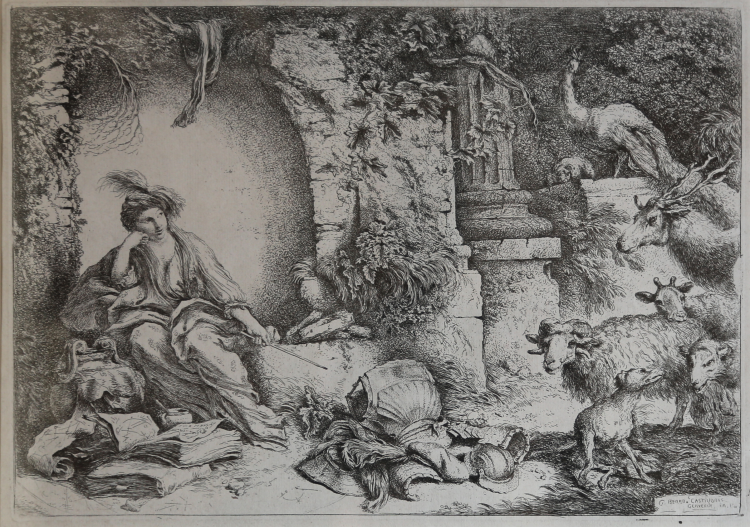



| Reference: | S39070 |
| Author | Giovanni Benedetto CASTIGLIONE detto "Il Grechetto" |
| Year: | 1650 |
| Measures: | 300 x 210 mm |


| Reference: | S39070 |
| Author | Giovanni Benedetto CASTIGLIONE detto "Il Grechetto" |
| Year: | 1650 |
| Measures: | 300 x 210 mm |
Etching, circa 1650-55, inscribed, lower right: G. BENEDs. CASTILIONUS/ genvensis in Pin.
Example of the first state, of two described by Bellini.
Magnificent proof, rich in shades, printed on contemporary laid paper, with thin margin, in excellent condition.
Castiglione's Genoese origin is indicated by the word 'genuensis' in the signature on this etching that shows both his stylistic debt to Rembrandt's prints of the 1630s and 40s and his own interest in subjects based on classical literature and symbol. His depictions of scenes of magical transformation may have been partly prompted by an interest in the occult. This is one of several works depicting Circe the sorceress, who is described in various classical sources surrounded by animals that she has transformed from human form. Homer and Ovid tell the story of her feeding Ulysses' crew a potion and then turning them into swine by touching their hair with her wand.
|
Bartsch, XXI n. 22; Le Blanc, I n. 58; Bellini, n. 60 I/II; Massari, Tra mito e allegoria, p. 416, 157, I/II.
|
Giovanni Benedetto CASTIGLIONE detto "Il Grechetto" (Genova 1616 - Mantova 1670)
|
His origin and his edication in Genua led Castiglione to make acquaitance with the Flemish painting, especially through Jaan Roos e Van Dyck from whom he took the warm, vibrating chromatism.
He lived in Rome from 1632 to 1635 and from 1647 to 1651; among the two periods in Rome, he lived in Naples and he also started studying the intellectualistic classicism of Poussin.
His favourite subjects, both in painting and engraving, were taken from the classical moralism of Stoicism, very typical in Poussin, which enabled him to create his own peculiar repertoire, much more refined in comparison with contemporary artists.
He spent his last working years in Mantua, at the Duke’s Palace; the production of this period enhances his chromatism and the visionary elements of his previous production.
Castiglione has been a silful engraver; he loved this particular art for he thought it was the main mean to widespread his iconography. He was the first, in Italy, to appreciate and imitate Rembrandt.
|
|
Bartsch, XXI n. 22; Le Blanc, I n. 58; Bellini, n. 60 I/II; Massari, Tra mito e allegoria, p. 416, 157, I/II.
|
Giovanni Benedetto CASTIGLIONE detto "Il Grechetto" (Genova 1616 - Mantova 1670)
|
His origin and his edication in Genua led Castiglione to make acquaitance with the Flemish painting, especially through Jaan Roos e Van Dyck from whom he took the warm, vibrating chromatism.
He lived in Rome from 1632 to 1635 and from 1647 to 1651; among the two periods in Rome, he lived in Naples and he also started studying the intellectualistic classicism of Poussin.
His favourite subjects, both in painting and engraving, were taken from the classical moralism of Stoicism, very typical in Poussin, which enabled him to create his own peculiar repertoire, much more refined in comparison with contemporary artists.
He spent his last working years in Mantua, at the Duke’s Palace; the production of this period enhances his chromatism and the visionary elements of his previous production.
Castiglione has been a silful engraver; he loved this particular art for he thought it was the main mean to widespread his iconography. He was the first, in Italy, to appreciate and imitate Rembrandt.
|